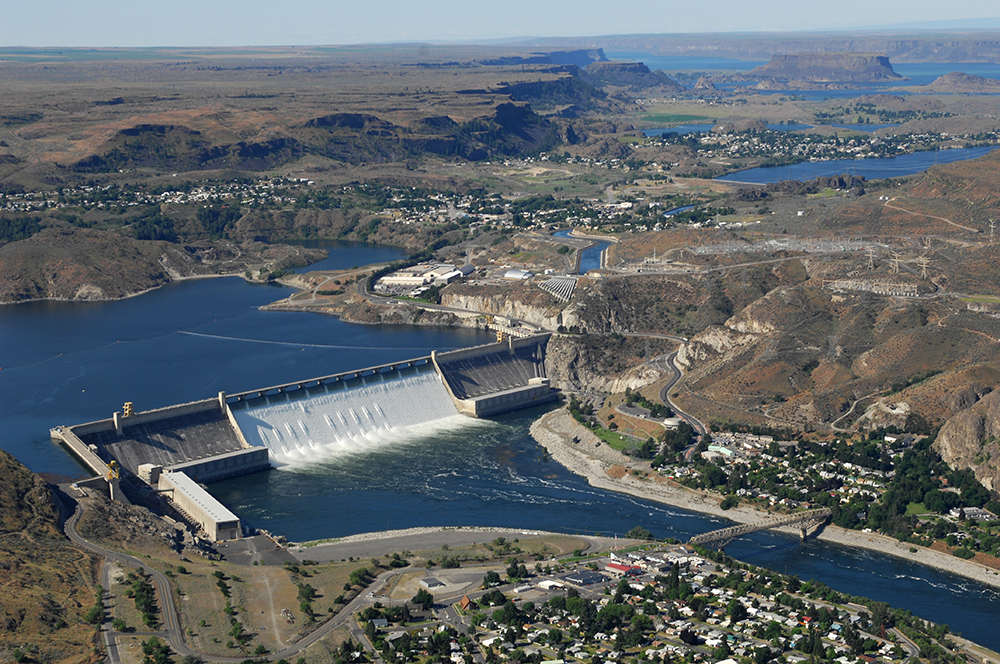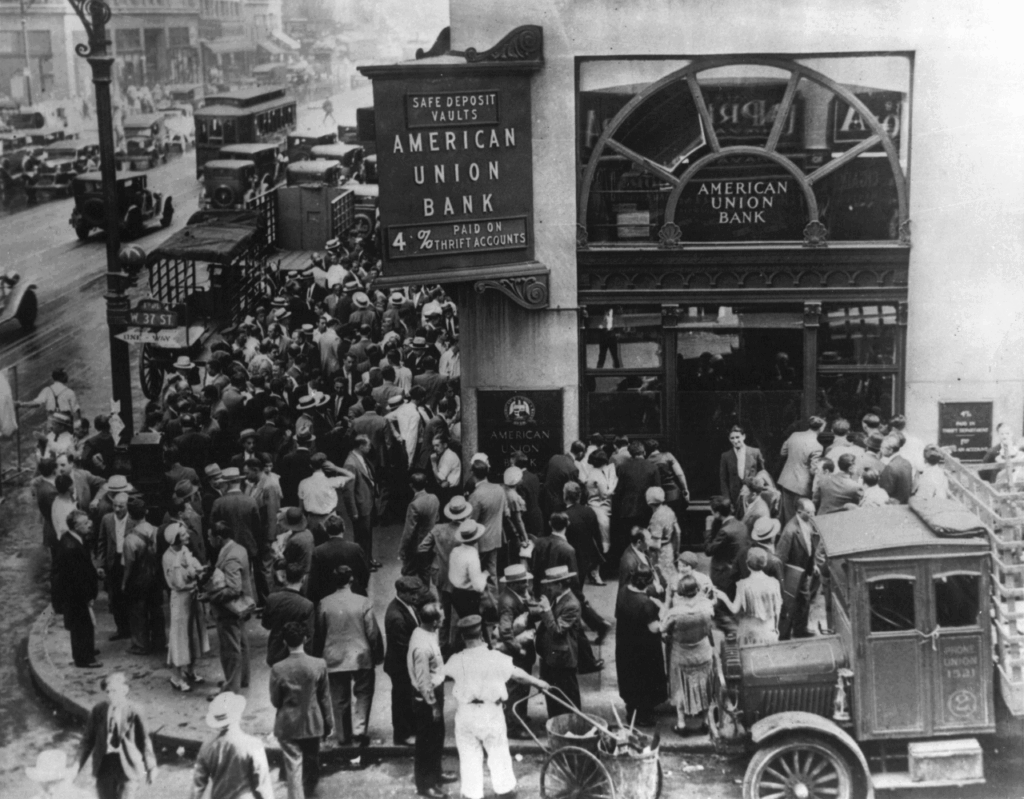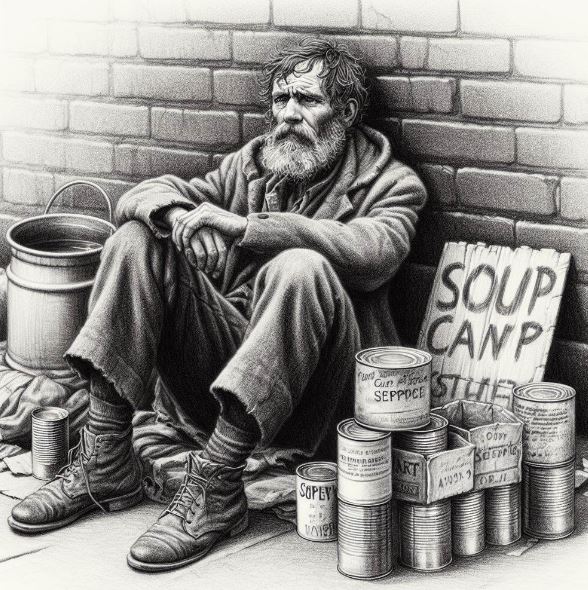On Thursday, October 24, 1929, stock prices in the New York Stock Exchange suddenly plummeted. As soon as the market opened that day, investors started dumping their stocks, causing the Dow Jones Industrial Average to begin a steep decline, dropping 12% in just one day. This marked the start of a continuous decline that led to the collapse of the stock market over the course of that month.
This period followed World War I, during which stock prices had more than doubled. This day, known as “Black Thursday,” marked the beginning of the Great Depression, which would oppress the global economy for a decade. The Dow Jones Industrial Average, which had once peaked at 386.10, plummeted to 40.56 by July 1932, a near 90% decline, leaving investors with only 10% of their initial investment value.

Consequently, most of the funds invested in the stock market evaporated, and banks that had heavily invested their cash reserves in stocks went bankrupt one after another. The collapse of these banks led to a domino effect, causing businesses unable to secure investment funds to fail and workers to be pushed into unemployment. By 1932, America’s Gross National Product had halved compared to 1929, the year the depression began, and unemployment exceeded 12.5 million people, nearly 25% of the workforce.
As the American economy faltered, Western Europe, which relied on the U.S. economy, also spiraled into depression, leading to a worldwide economic downturn. The depression’s impact resulted in 6 million unemployed in Germany and 3 million in the United Kingdom. Furthermore, many countries banned imports of foreign goods, reducing global trade by half.
Process The collapse of the stock market was not entirely without warning. Notably, economist Irving Fisher, famous for his equation of exchange, had remained optimistic, asserting that there would not be a severe recession because “inventions in the industrial sector are continually being made, keeping the economy healthy.”
However, the Great Depression did occur, and it brought about a change in government with the election of Franklin D. Roosevelt as the President of the United States under the Democratic Party.
“First of all, let me assert my firm belief that the only thing we have to fear is fear itself—nameless, unreasoning, unjustified terror which paralyzes needed efforts to convert retreat into advance,” said Roosevelt during his inaugural address. His radio talks, known as “fireside chats,” had an almost magical effect on the American public, rallying enthusiastic support for his policies. The government gained the strength to boldly implement the New Deal policies.

Construction of Grand Coulee Dam, often dubbed “the eighth wonder of the world,”
provided a tremendous boost to the regional economy during the Depression years.
A concrete gravity dam, Grand Coulee took eight years to build, employed thousands of men during the Great Depression and, when completed in 1942, provided the enormous electrical power necessary to make aluminum, so essential for World War II production of planes and ships.
The New Deal combined Keynesian economic theories and the British social security system’s approach to welfare, representing not just a test of Keynesian economics but a bold attempt towards a more equitable society. Keynes had argued that it was unrealistic for an economy to maintain full employment at all times because people tend to save part of their income, which could not always be entirely invested by businesses, generally leading to unemployment.
Based on these theories, Roosevelt’s New Deal policies were implemented. For example, the Agricultural Adjustment Act of May 1933 was introduced to regulate overproduction of crops, aligning supply with demand to prevent price crashes and increase farm incomes. In June 1933, the Industrial Recovery Act set maximum production limits for various industries to prevent overproduction, alongside large-scale public works projects like the Tennessee Valley Authority to create jobs and increase workers’ purchasing power.
Four years after implementing the New Deal policies, America’s GNP had returned to pre-depression levels, and 6 million new jobs were created. However, the unemployment rate remained high, recording 14.6 percent in 1940.
Causes of the Crisis
Around 1920, the world’s factories moved from the UK, the birthplace of the Industrial Revolution, to the United States. The US had quickly become the center of the global economy, holding 40% of the world’s assets. What we might take for granted today is that not long ago, the US was merely an emerging nation populated by Europeans who had failed to find success in their home continent.
Following World War I, the US heavily invested in its facilities. With the invention of electricity and its application in industry, along with the production techniques developed by Ford and Taylor, the US achieved rapid increases in productivity. Like Europe in the 19th century, which awaited a utopian age, the US expected an era of material abundance to dawn. On November 2, 1920, a radio station in Pittsburgh started broadcasting at set times, heralding the development of mass media. By the late 1920s, 21.2 million cars were on American roads, and pop culture elements like music and films were ushering in a new era.
This rapid technological and industrial advancement led to increased consumption, and the newly established Federal Reserve began lowering interest rates and endlessly issuing money. New banks were established, and these banks increased their lending. The stock market introduced the margin loan system, which allowed people to pay just 10% of a stock’s price and borrow the rest to buy shares. As everyone jumped into the stock market, the market soared, creating a virtuous cycle of rising consumption.
However, this virtuous cycle turned vicious when banks started to recall loans as debt soared and unpaid balances in the stock market spiked. This was the gradual onset of the Great Depression. Although the collapse of the stock market was the most noticeable sign, signs of a downturn had already appeared in the real economy.
Firstly, a production decrease had already been evident across Europe at that time. Additionally, the peak of real estate prices in the US in 1925 was already in decline. In the US, thanks to innovations in production methods by Ford and Taylor, productivity had reached its zenith. Supported by government policies favoring businesses, manufacturing output in sectors like the automotive industry had increased by 64% over ten years. Up until then, the global economy operated under the belief that “supply creates its own demand,” leading factories to produce goods at high rates. However, the workers who needed to buy these goods lacked the money. While corporate sales and profits continued to rise, personal income growth was minimal, leading to accumulated inventories.
In fact, the US GNP showed a decline starting from the first quarter of 1929. Specifically, automobile production decreased from 622,000 units in March to 416,000 units in September. However, due to high stock prices, nobody paid attention to this downturn in the real economy.
The trigger for the Great Depression was financial policy, and the immediate culprits were the speculative bubbles in the stock market, underpinned by debt. Nonetheless, the root cause was the excess supply in the real economy.
The Federal Reserve was established in 1914. From that point, the US maintained the gold standard in principle but began experimenting with adjusting the currency supply through reserve ratios and interest rates, based on a judgment that the money supply should flexibly respond to the real economy. The Federal Reserve was very encouraged by the rationality and scientific approach of monetary policy, which could finely adjust the currency supply through open market operations.

Crowd at New York’s American Union Bank during a bank run early in the Great Depression
American union bank – Great Depression – Wikipedia
In 1923, Benjamin Strong, the then president of the New York Federal Reserve Bank, bought a large amount of government bonds to prevent an economic downturn, effectively increasing the money in circulation. Previously, increasing the money supply required gold, but government bonds were allowed to replace gold. Between 1927 and 1928, the total US currency supply grew by 3.8%. The US government had to begin financial tightening to catch the bubble, and in February 1928, the Federal Reserve sharply increased the base interest rate from 3.5% to 6%, tightening the money supply. Investors who had borrowed against their stocks were forced to sell off their shares, plunging the stock market into a deep trough.
In the end, the Great Depression was a result of financial policies sharply pulling the economy from a period of excess supply into a deep recession, exacerbating the business cycle.
Despite this, economists still slightly differ in their opinions on the causes of the Great Depression. Keynesian economists argue that it was due to a reduction in demand, consumption, investment, and net exports. On the other hand, monetarists like Milton Friedman and his colleague Anna Schwartz, in their book A Monetary History of the US, 1867–1960, argued that a recession that could have ended as a mild temporary downturn was driven into the Great Depression by poor economic policies of the US government. They believe that the Federal Reserve’s inadequate response despite a reduction in the money supply was a major cause of the Great Depression.
In 1929, the US Federal Reserve should have abandoned its tightening policy and supplied more funds. From today’s perspective, this may seem like an obvious course of action, but the Federal Reserve members at that time were not yet familiar with this new world of currency. They were accustomed to a world where money was backed by gold, focusing heavily on the principal recovery like private banks. The Congress and then-President Hoover also reduced fiscal spending, echoing the old virtue that in hard times, both the government and the citizens should tighten their belts and reduce consumption.
Overcoming the Crisis and Its Aftermath
How long did it take for the stock prices, which had plummeted during the American depression, to recover? It took 24 years.
The New Deal policies did not create permanent jobs, leading to a rise in unemployment to 10 million by 1938. Critics of the policy have pointed out that “had it not been for the wartime boom brought about by the outbreak of World War II in 1939, the New Deal would have been recorded as a failure.” Milton Friedman also criticized that “the New Deal policies only prolonged the depression.”
It is true that President Franklin Roosevelt’s New Deal policies did not complete their true experiment due to World War II.
However, at least four lessons were learned from this Great Depression. One is about leadership in a crisis. Regardless of the success of the New Deal, Roosevelt’s leadership, which sustained the nation until overcoming the depression, was successful. By continuously introducing new measures and showing a firm resolve to solve the economic crisis, he soothed the nation’s pain and eventually restored trust in the government.
Secondly, although incomplete, it began an experiment on the role of government during economic downturns. Indeed, both monetarists and Keynesian scholars can say that this historical crisis led to academic achievements in economics from a macroeconomic perspective. Above all, it provided insights into a monetary policy not based on gold. It was also recognized that inconsistent or aimless monetary policies could lead to disaster.
Moreover, it was recognized that fiscal policy could help during an economic downturn. Of course, there are costs involved, but as Galbraith said, “when the ship starts sinking, the central bank’s first duty is to escape by any means necessary,” it’s hard to argue against saving the ship first when the economy is rapidly declining.
Before the Great Depression, classical economics, which asserts that supply creates demand through the theory of full employment, was the mainstream. But now, no one claims that the market automatically maintains full employment.
This is because effective demand might fall short of potential demand. Potential demand refers to all people who have the desire to consume. However, not all of these people have the purchasing power. In other words, if there’s a desire but no money, it’s not effective demand.
Therefore, only effective demand with purchasing power determines the level of economic activity at any given time. For a society to achieve full employment, all income must be spent or invested. This would keep all money circulating in the income-creating loop. However, in reality, the money that circulates in this process is what is consumed by the private sector and invested by businesses. Money held as cash by businesses without investment or saved by households temporarily exits the income circulation, thus not aiding economic growth.
Hence, a nation’s economic activity is determined by consumption in the household sector and investment in the business sector, together constituting effective demand. If effective demand decreases, the level of national economic activity falls; if it increases, it grows.
This highlights the necessity for fiscal policy. If households reduce consumption and increase savings, the demand for products produced by businesses drops, forcing businesses to reduce production scales. If the government uses fiscal or financial policy to increase effective demand at this point, it can prevent an economic downturn.
This argument, while simple and seemingly valid, comes with costs. These costs are what we discussed as crowding out effects during economic fluctuations.
However, during the economic crisis that began in 2008, it was difficult for anyone to oppose government fiscal spending due to crowding-out effects. Once the economy begins to gain upward momentum, however, the possibility of crowding-out effects should be considered, and the forces of economic growth should be sought again in the market.
Thirdly, there are issues related to wealth inequality and job stability. While the New Deal often brings to mind Keynesian economic theories, at the core of the New Deal was a state-led welfare policy from “cradle to grave.” Paul Krugman, the Nobel laureate in economics in 2008, called this period the “Great Compression,” a term used to signify a substantial reduction in the disparity between the rich and the poor. Krugman defines pre-New Deal America as nominally a democracy but rampant with inequality in wealth and power, failing to represent the economic interests of the majority. The New Deal, according to Krugman, reduced the income gap, the differences between the wealthy and the working class, and even the wage differences among workers, making this era relatively rich in middle class and economically equal.
The New Deal led to the creation of the Social Security Act, providing a safety net for the socially disadvantaged and raising taxes on corporations and the wealthy, heralding the most equal era of prosperity in American history. Indeed, in 1935, Roosevelt, through the Social Security Act, guaranteed workers’ rights to unionize and bargain for wages, and specified minimum wages and maximum working hours, marking the first measures to protect workers’ rights. This series of policies was called modified capitalism. Ultimately, expanding the role of the state, protecting workers’ rights, and social security slightly changed the policies of traditional capitalism.
However, as America entered the 1970s, wealth inequality worsened. Krugman points to the reduction in income taxes on the wealthy and wage disparities as evidence. For example, the top marginal tax rate on income dropped from 70% in the early 1970s to 35%, and while the salary difference between CEOs and regular workers was 40 times in the 1930s, it exceeded 367 times in the early 2000s. American society is more affluent than ever, but the benefits are enjoyed by a very few. Such inequality accumulates until it reaches a tipping point, rushing towards a moment of drastic change.


